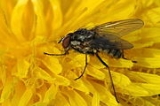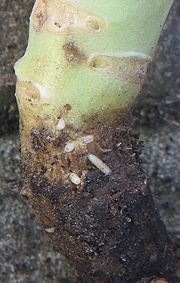
Cabbage root fly
Encyclopedia
Delia radicum, known variously as the cabbage fly, cabbage root fly, root fly or turnip fly, is a pest of crops
. The larvae of the cabbage root fly are sometimes known as the cabbage maggot or root maggot. The adult flies are approximately 1 cm long and are grey in colour but otherwise resemble the common house fly.
The flies can be found all over Europe
. After over-wintering as pupa
e in the soil
, the flies hatch in spring, feed on nectar and lay eggs
close to plants of the genus
Brassica
. The eggs are white and about 1 milimetre in diameter. They hatch into white maggot
s after about six days and the larva
e feed for about three weeks on the roots and stems of the cabbage plants. After this, the larvae are typically 0.9 to 1 cm in length and form reddish brown pupae which hatch into adult flies after around 20 days. This species is monovoltine (has one generation a year) in northern Europe and bi- or trivoltine in central Europe.

Crop (agriculture)
A crop is a non-animal species or variety that is grown to be harvested as food, livestock fodder, fuel or for any other economic purpose. Major world crops include maize , wheat, rice, soybeans, hay, potatoes and cotton. While the term "crop" most commonly refers to plants, it can also include...
. The larvae of the cabbage root fly are sometimes known as the cabbage maggot or root maggot. The adult flies are approximately 1 cm long and are grey in colour but otherwise resemble the common house fly.
The flies can be found all over Europe
Europe
Europe is, by convention, one of the world's seven continents. Comprising the westernmost peninsula of Eurasia, Europe is generally 'divided' from Asia to its east by the watershed divides of the Ural and Caucasus Mountains, the Ural River, the Caspian and Black Seas, and the waterways connecting...
. After over-wintering as pupa
Pupa
A pupa is the life stage of some insects undergoing transformation. The pupal stage is found only in holometabolous insects, those that undergo a complete metamorphosis, going through four life stages; embryo, larva, pupa and imago...
e in the soil
Soil
Soil is a natural body consisting of layers of mineral constituents of variable thicknesses, which differ from the parent materials in their morphological, physical, chemical, and mineralogical characteristics...
, the flies hatch in spring, feed on nectar and lay eggs
Egg (biology)
An egg is an organic vessel in which an embryo first begins to develop. In most birds, reptiles, insects, molluscs, fish, and monotremes, an egg is the zygote, resulting from fertilization of the ovum, which is expelled from the body and permitted to develop outside the body until the developing...
close to plants of the genus
Genus
In biology, a genus is a low-level taxonomic rank used in the biological classification of living and fossil organisms, which is an example of definition by genus and differentia...
Brassica
Brassica
Brassica is a genus of plants in the mustard family . The members of the genus may be collectively known either as cabbages, or as mustards...
. The eggs are white and about 1 milimetre in diameter. They hatch into white maggot
Maggot
In everyday speech the word maggot means the larva of a fly ; it is applied in particular to the larvae of Brachyceran flies, such as houseflies, cheese flies, and blowflies, rather than larvae of the Nematocera, such as mosquitoes and Crane flies...
s after about six days and the larva
Larva
A larva is a distinct juvenile form many animals undergo before metamorphosis into adults. Animals with indirect development such as insects, amphibians, or cnidarians typically have a larval phase of their life cycle...
e feed for about three weeks on the roots and stems of the cabbage plants. After this, the larvae are typically 0.9 to 1 cm in length and form reddish brown pupae which hatch into adult flies after around 20 days. This species is monovoltine (has one generation a year) in northern Europe and bi- or trivoltine in central Europe.


